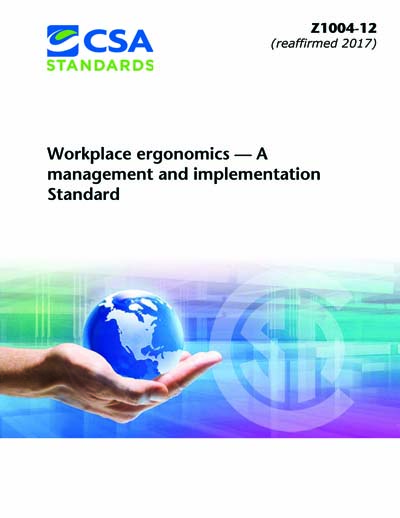Historical
CSA Z1004-12 (R2021)
Workplace ergonomics - A management and implementation Standard
Preface This is the first edition of CSA Z1004, Workplace ergonomics - A management and implementation Standard. This Standard sets out requirements and provides guidance for the systematic application of ergonomics to the development, design, use, management, and improvement of work systems through the implementation of an Ergonomics Process. The objective of this Standard is to enable an organization to enhance worker health, safety, and well-being and optimize system performance to prevent occupational injuries, illnesses, and fatalities and/or reduce the severity of harm related to occupational activities and work environments. Scope and objective 1.1 Scope 1.1.1 This Standard specifies requirements and provides guidance for the systematic Application of Ergonomics to the development, design, use, management, and improvement of work systems through the implementation of an Ergonomics Process. 1.1.2 This Standard does not apply to medical management programs or to aspects that could be considered part of a medical management program, such as therapeutic or clinical interventions. 1.2 Objective The objective of this Standard is to enable an organization to enhance worker health, safety, and well-being and optimize system performance to prevent occupational injuries, illnesses, and fatalities and/or reduce the severity of harm related to occupational activities and work environments through the systematic Application of Ergonomics. Prevention strategies proactively identify hazards and eliminate them where possible. Where elimination is not possible, prevention can be achieved through appropriate risk assessment and control techniques. 1.3 Terminology In CSA standards, "shall" is used to express a requirement, i.e., a provision that the user is obliged to satisfy in order to comply with the standard; "should" is used to express a recommendation or that which is advised but not required; and "may" is used to express an option or that which is permissible within the limits of the standard. Notes accompanying clauses do not include requirements or alternative requirements; the purpose of a note accompanying a clause is to separate from the text explanatory or informative material. Notes to tables and figures are considered part of the table or figure and may be written as requirements. Annexes are designated normative (mandatory) or informative (non-mandatory) to define their application.
CSA America, Inc. [csa]

